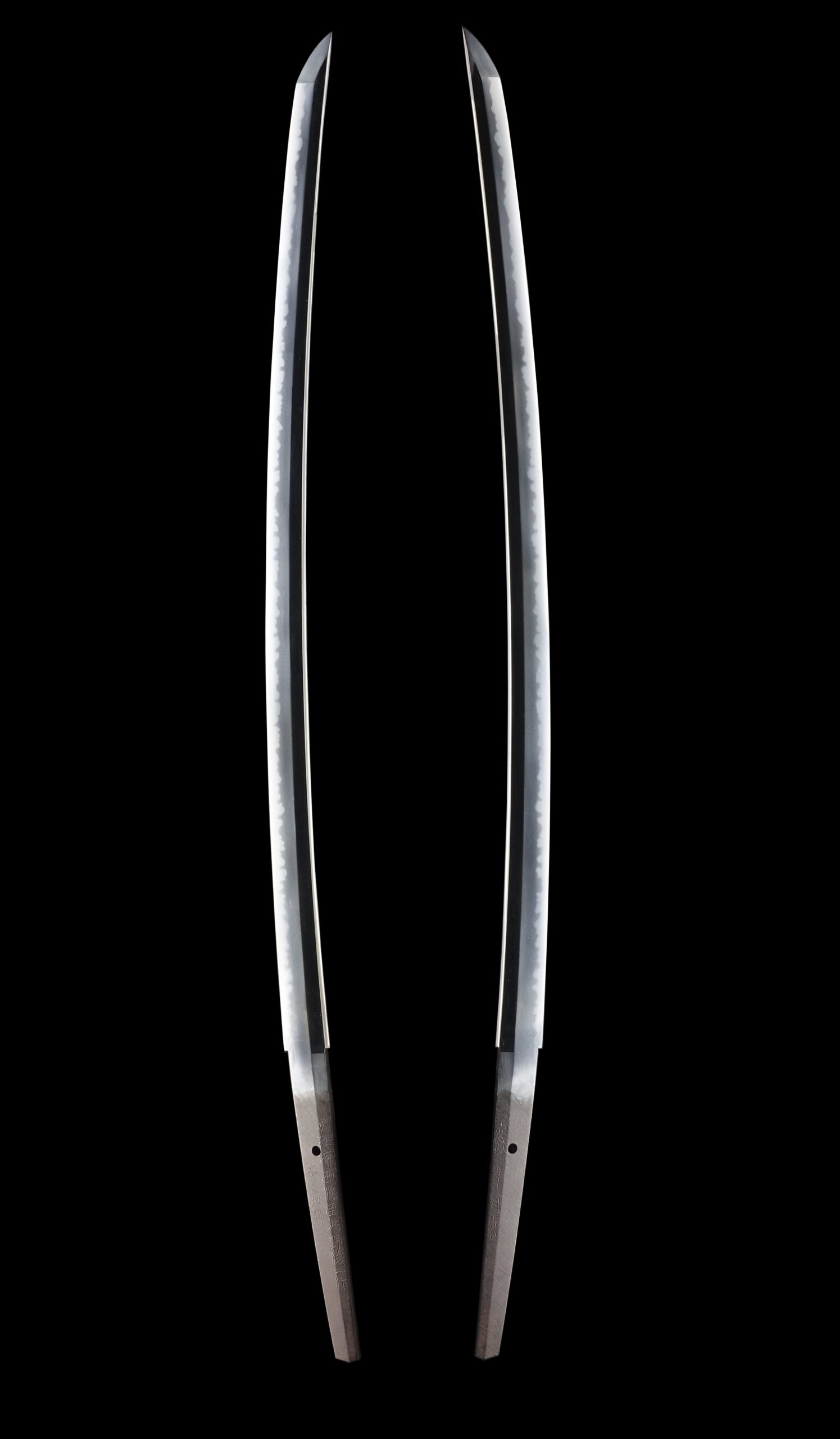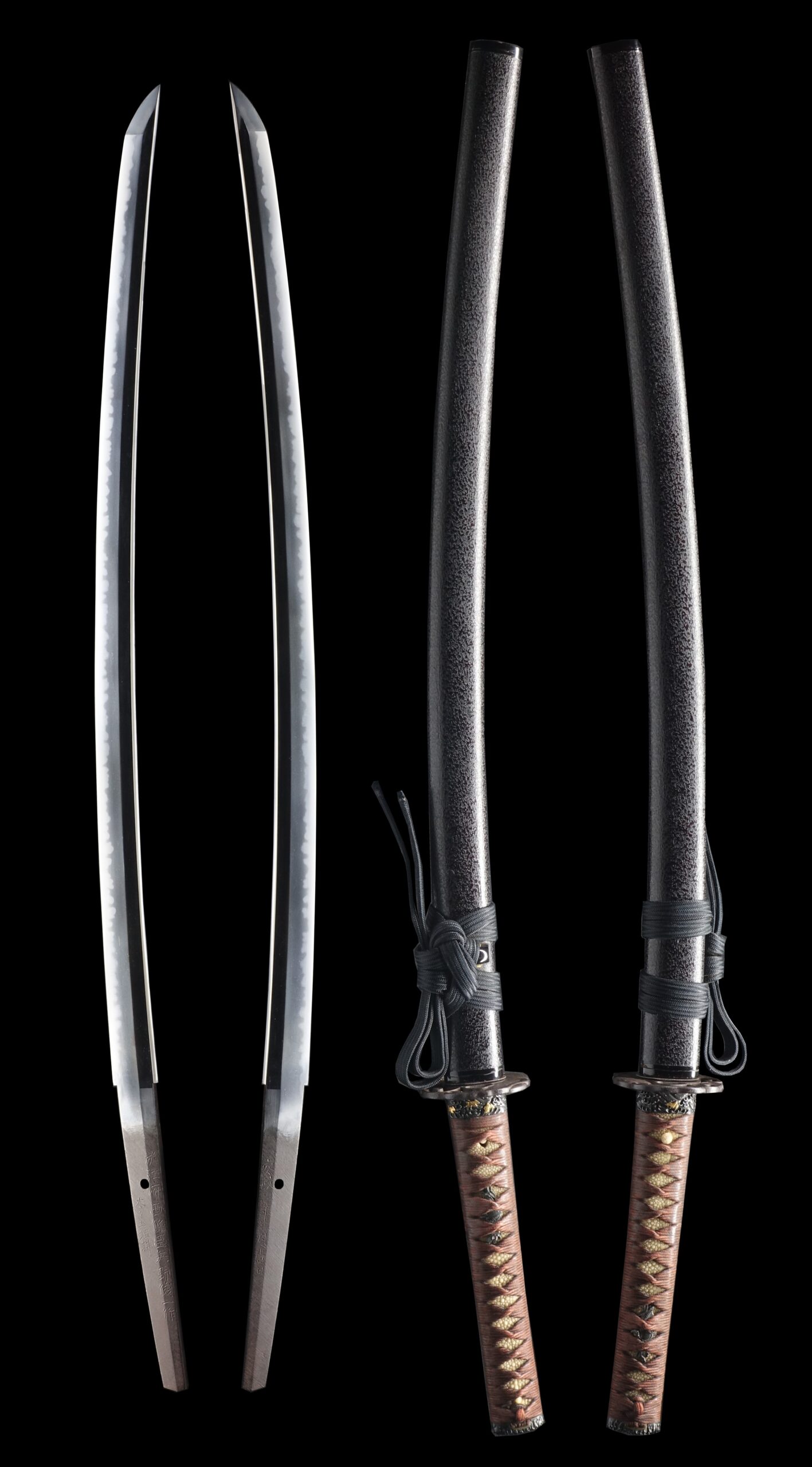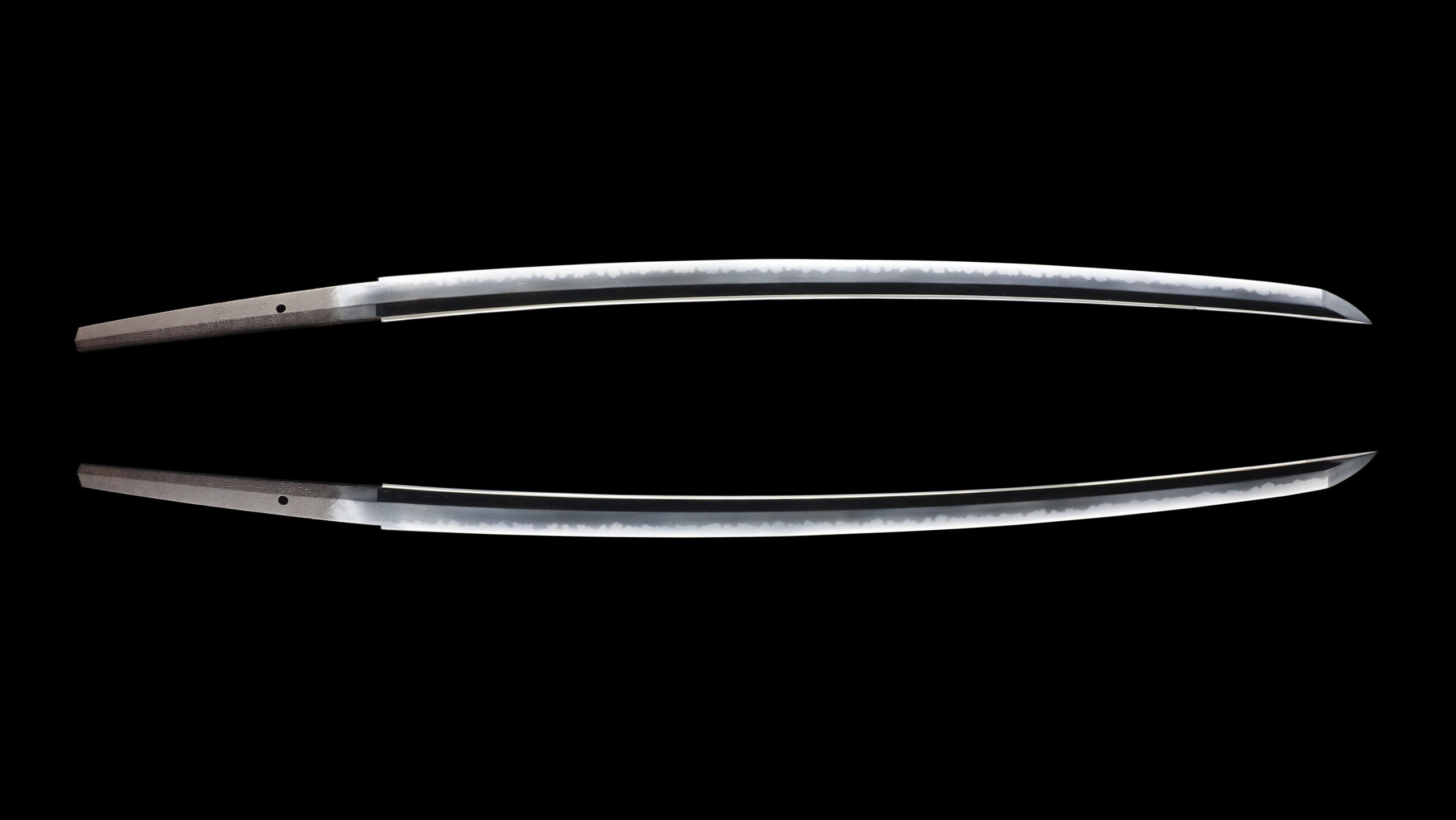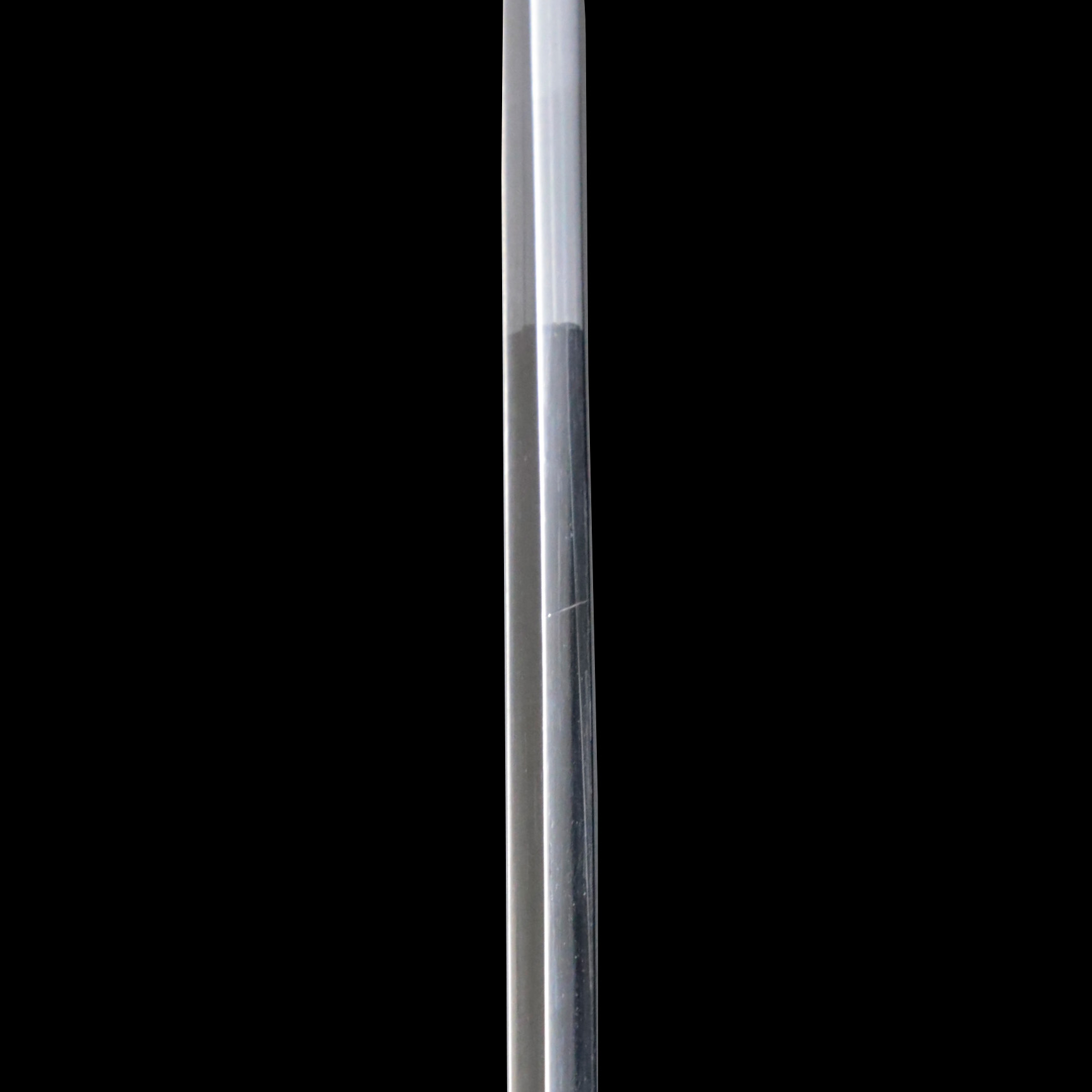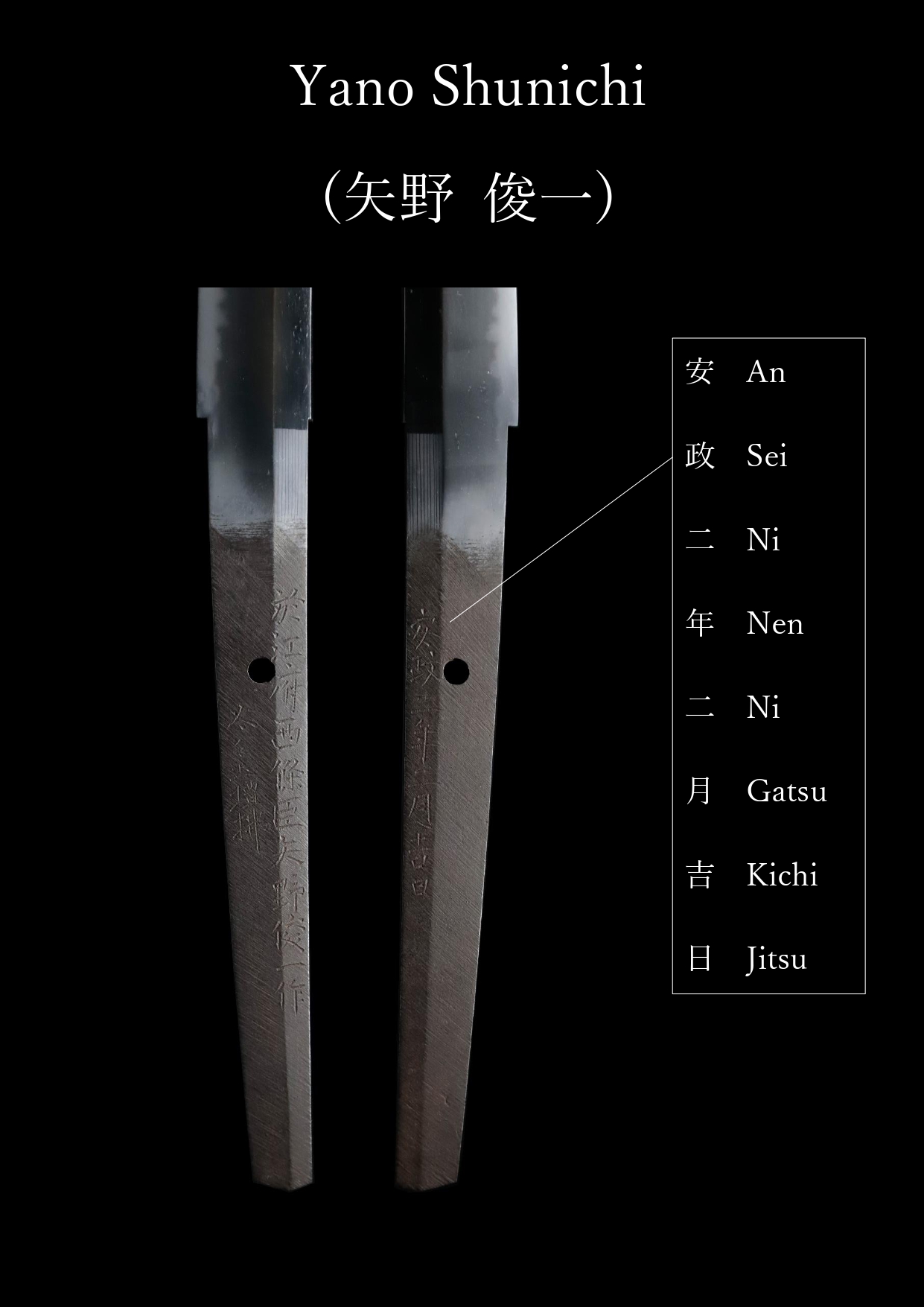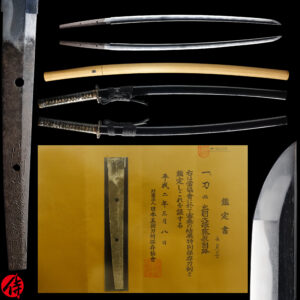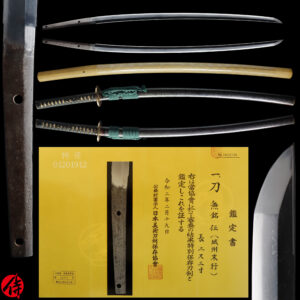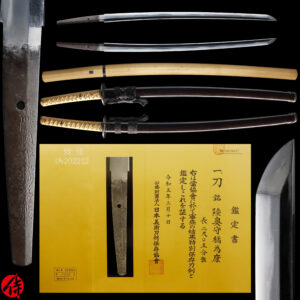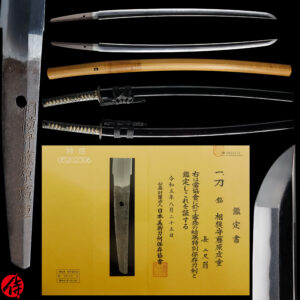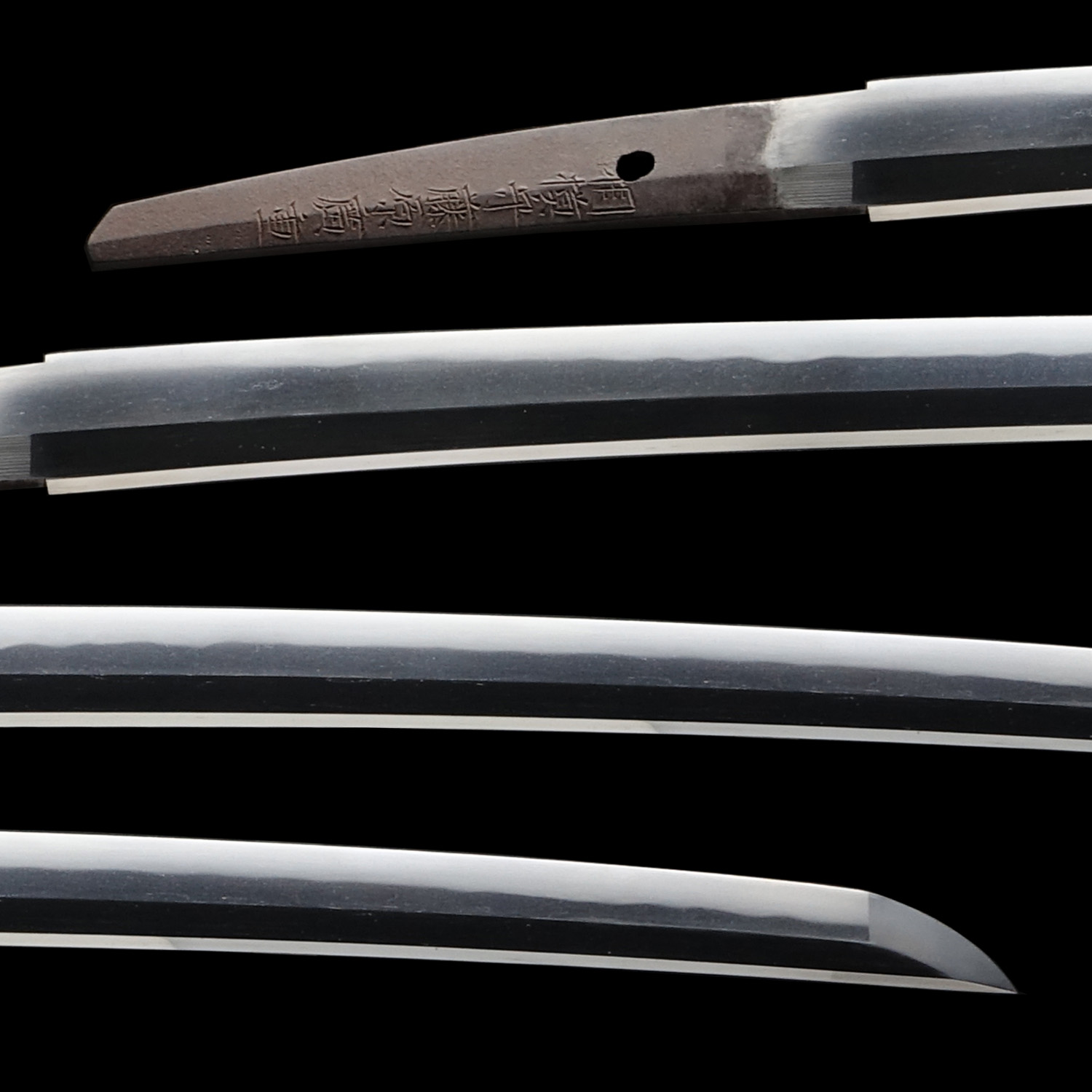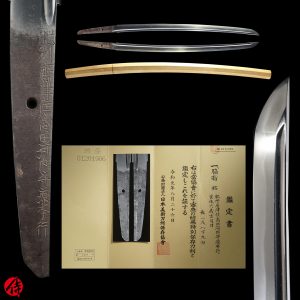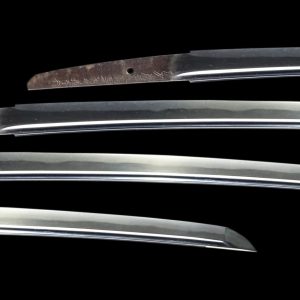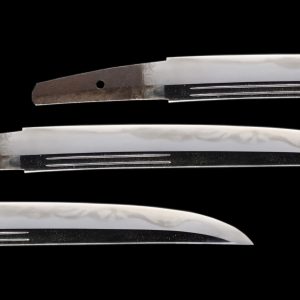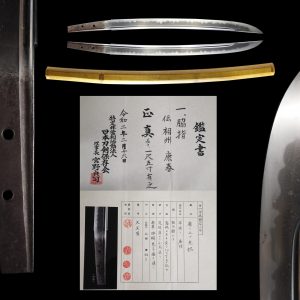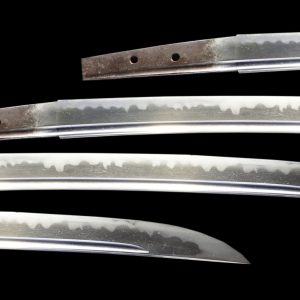Antique Japanese Sword Katana Tameshigiri Mei Signed by Toshikazu with Tokubetsu Hozon Certificate
【Description】
Summary
This blade was signed by Saijyounoshin Yano Toshikazu (西條臣矢野俊一) in the second year of the Ansei era (1855: At the end of the Edo period). He was an apprentice of Chounsai Tsunatoshi, one of the most famous swordsmiths at the end of the Edo period. Toshikazu lived in Yotsuya, Edo (today’s Tokyo). He also served the Saijyo clan, who ruled a part of the Iyo domain (today’s Ehime prefecture). Saijyounoshin is the name of the title he received, and Yano is his family name. The signature also says that this blade was made in Edo City, judging from 於江府 inscription. One of the most intriguing characteristics of this blade is that it has Tameshigiri Mei (test cutting signature).
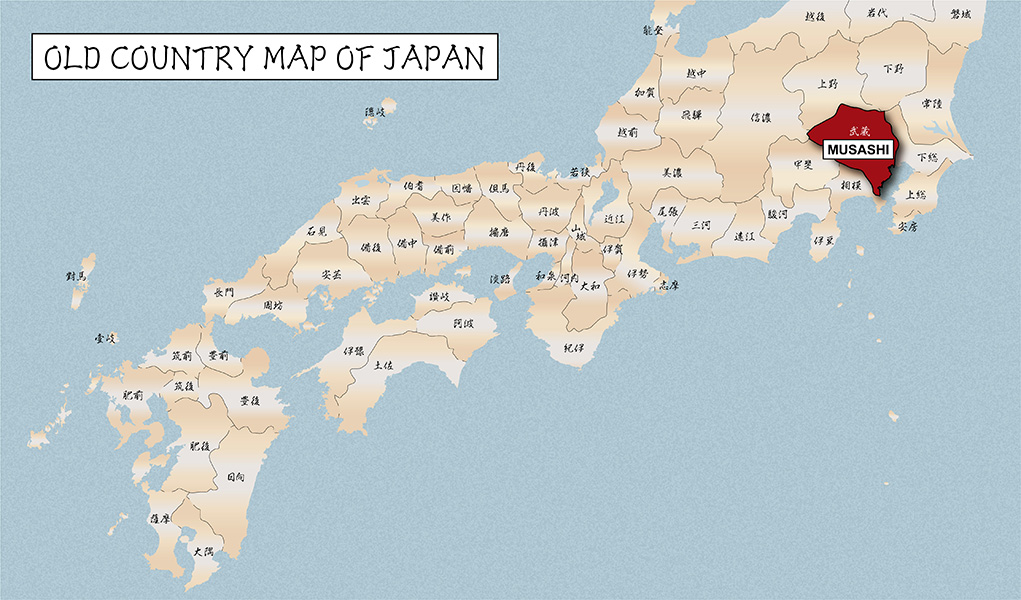
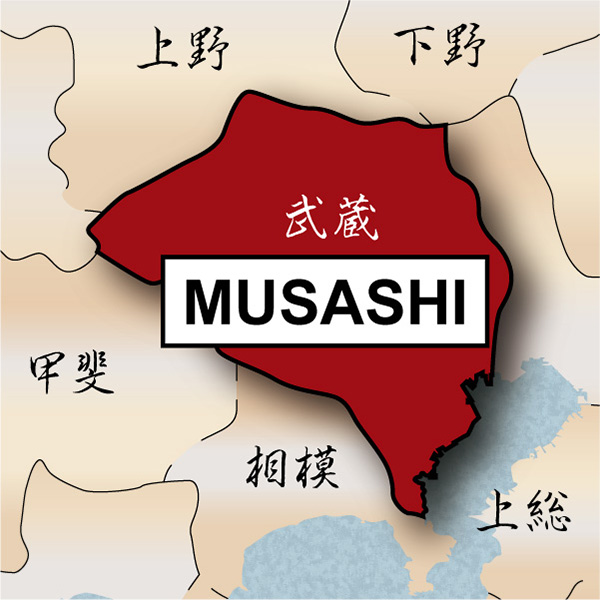
Tameshigiri (test cutting signature)
Based on the signature on the tang, it was used for Tamashigiri(test cutting). It is said that the dead bodies of inmates on death row were often subjected to Tameshigiri. According to the tang statement, this blade cuts through the shoulder to the chest area, which is considered the most hard-to-cut part of the human body. This statement proves this blade’s sharpness. Tata Dodan Barai (太々土壇拂) is the literal inscription on the tang. Tata refers to Scapula area. Dodan means the place for execution in ancient times in Japan. Since the Japanese sword was a practical weapon for Samurai, it was essential to prove the sharpness of one’s blade.
His master (Chounsai Tsunatsohi)
Tsunatoshi was born in 1798 in Yonezawa city, Hashu province (Yamagata prefecture) as the third son of Izumi no Kami Kunihide(和泉守国英). His family name was Kato, and he was the younger brother of Kato Tsunahide (加藤綱英). Tsunatoshi’s real name was Kato Hachiro. Tsunatoshi served Yonezawa Uesugi clan, a powerful feudal lord in today’s Yamagata prefecture.
During his early career, he moved to Edo city to learn superb sword-forging techniques from Suishinshi Masahide, one of the most renowned swordsmiths at the end of the Edo period.There is also a record of him forging swords in Osaka and Kumamoto while his base was in Azabu town in Edo city (Today’s Tokyo).
He settled in Edo city around 1823, and he created most of his work. He started to run his school there and resided in the house of Uesugi family. It is said that he received a stipend from them. He received the honorable title Chounsai (長運斎) in the first year of the Bunka era (1854).
The school Tsunatoshi belonged to flourished at the end of the Edo period, training many swordsmiths who later became historically significant ones. Tsunatoshi excelled at forging Bizen-Den tradition with Choji Midare Hamon, an irregular, wavy tempering line. Most of Tsunatoshi’s work reflects Bizen Den (One of the Five Japanese sword-forging traditions). In terms of Bizen Den tradition swords, it is said that Tsunatoshi school surpassed Suishinshi Masahide school. Also, his apprentice, Toshikazu, was excellent at forging blades with this tradition. You can see this Choji Midare tempering line from this blade.
It is appraised as a Tokubetsu Hozon Token(特別保存刀剣) issued by NBTHK(Nihon Bijutsu Touken Hozon Kyokai:日本美術刀剣保存協会). This authentication paper was only given to authentic Japanese swords, especially well preserved and high quality with artistic value.
*Please keep in mind that there are a couple of Kizu on the Mune (backbone of the blade) while they are all minor. If you like to know the detailed condition, please feel free to contact us.
【 Blade】
Cutting Edge Length(Nagasa): 62.2 cm (24.5 inches)
Curvature(Sori): 1.6 cm (0.63 inches)

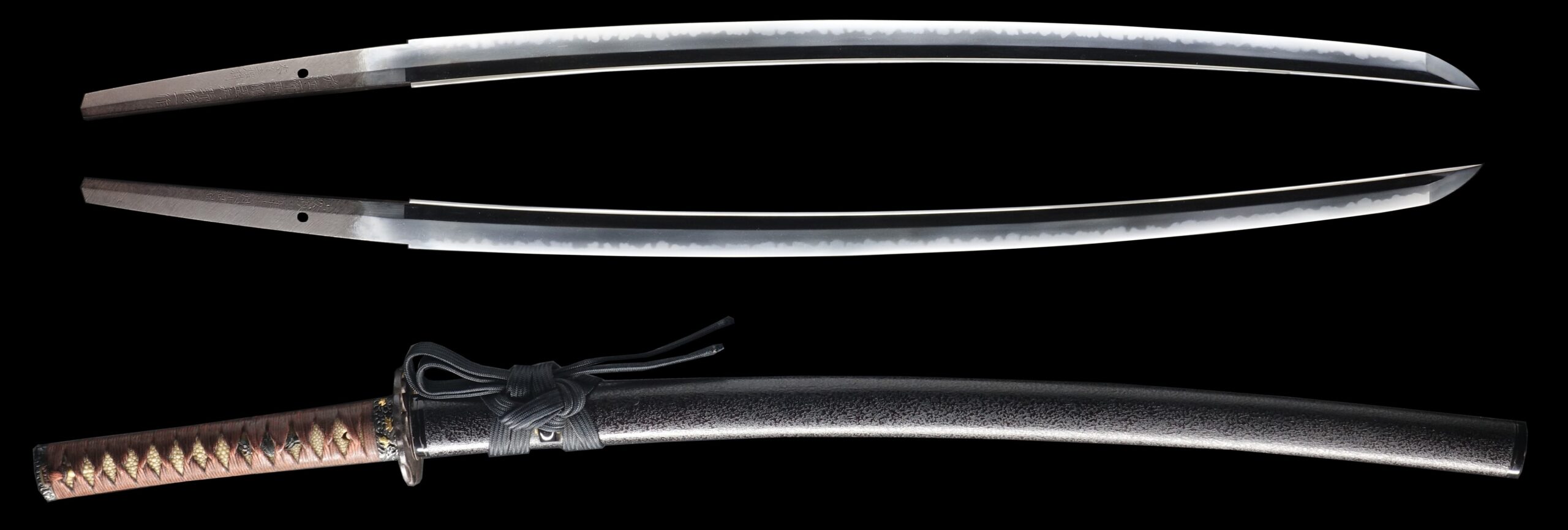
Hamon:
The crystalline structure which forms along the cutting edge of a blade as a result of the hardening process
Jimon(Jihada):
visible steel surface pattern created by folding and hammering during forging process
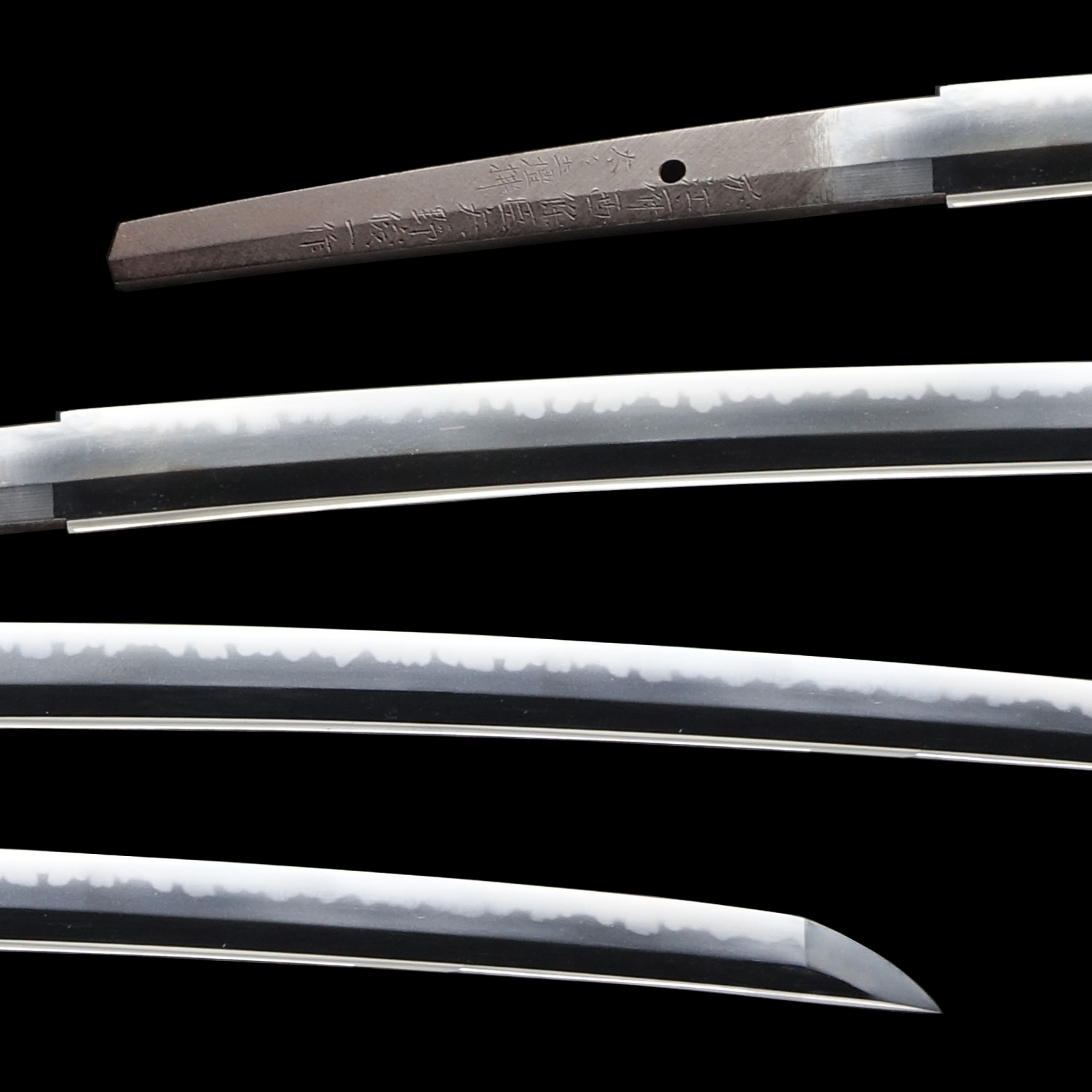

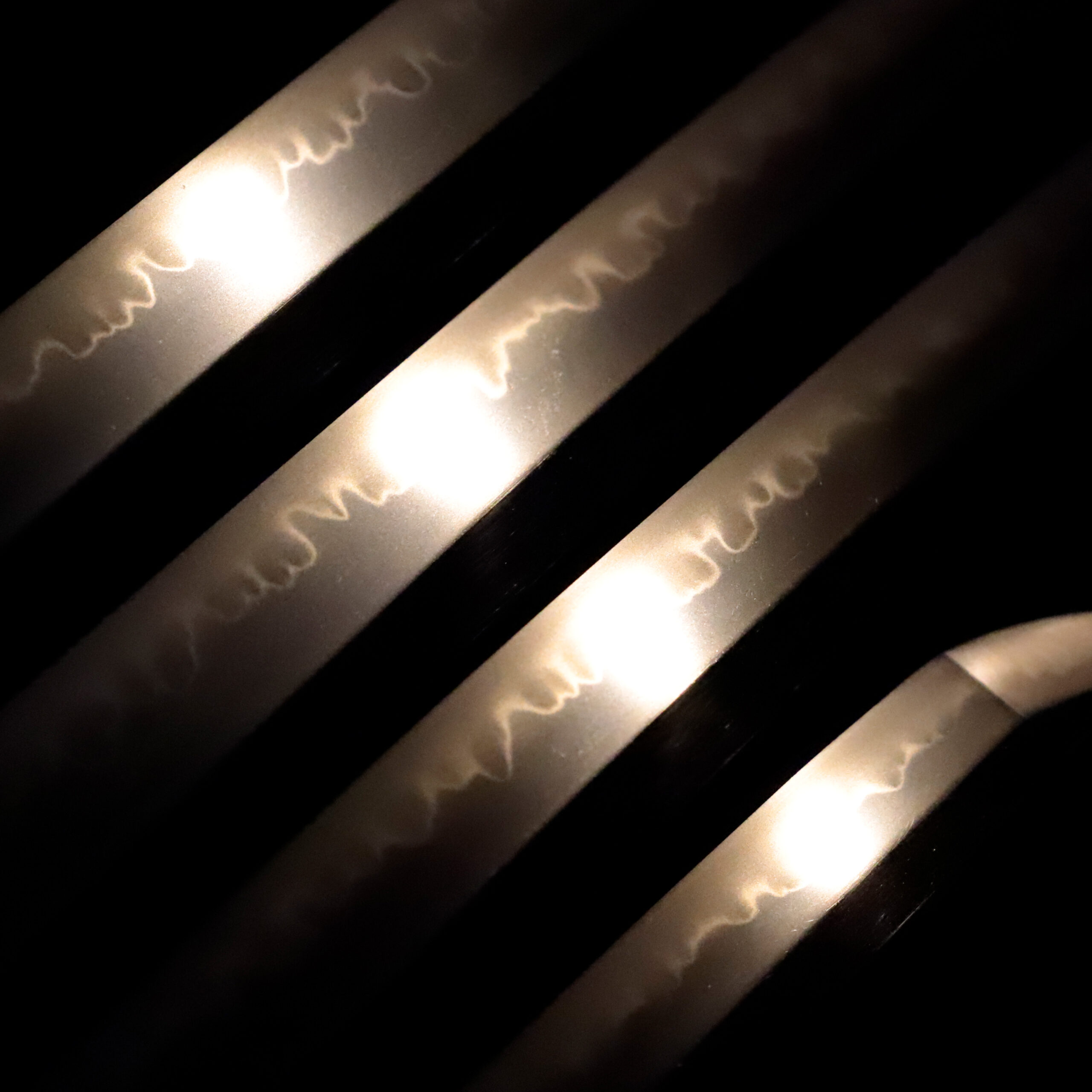
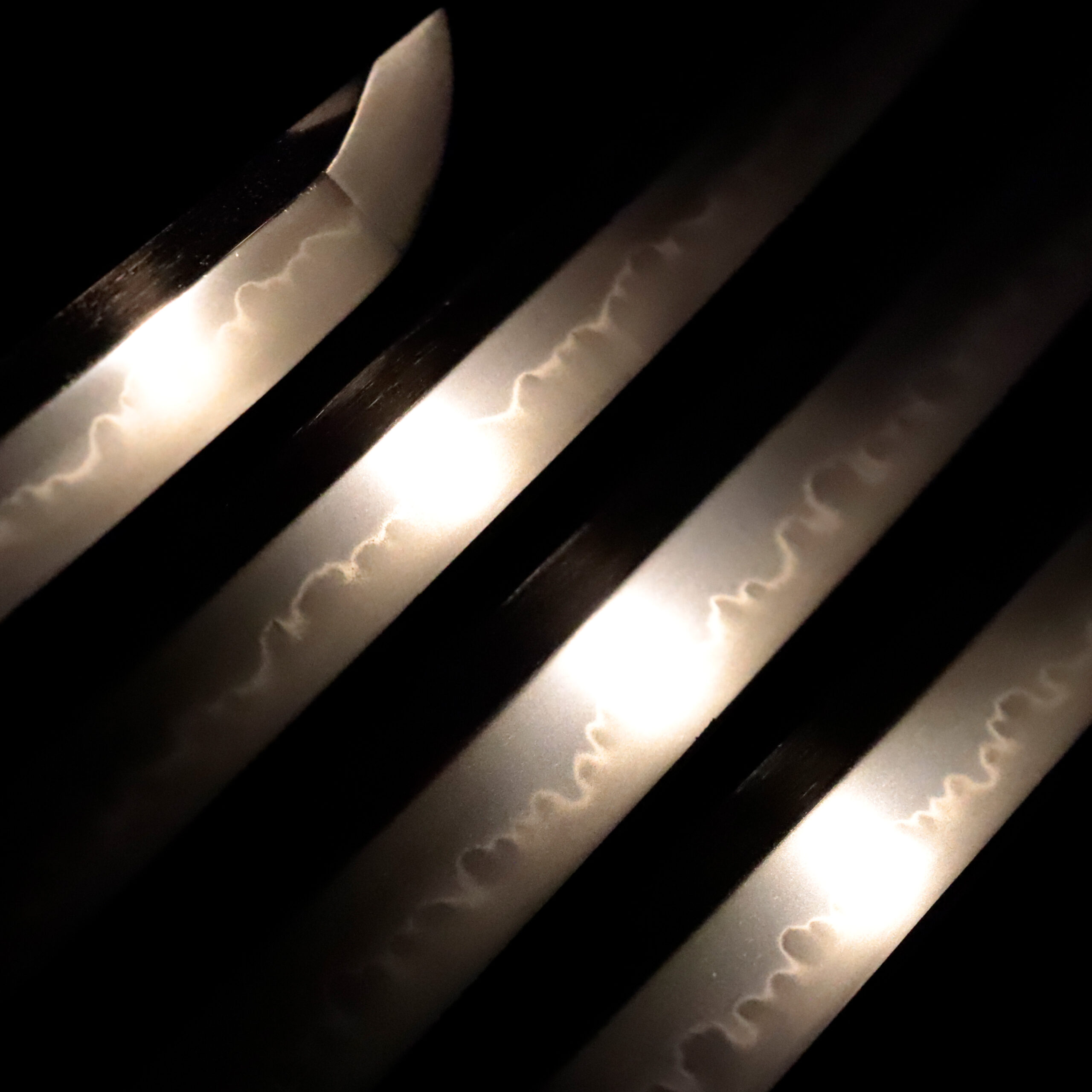

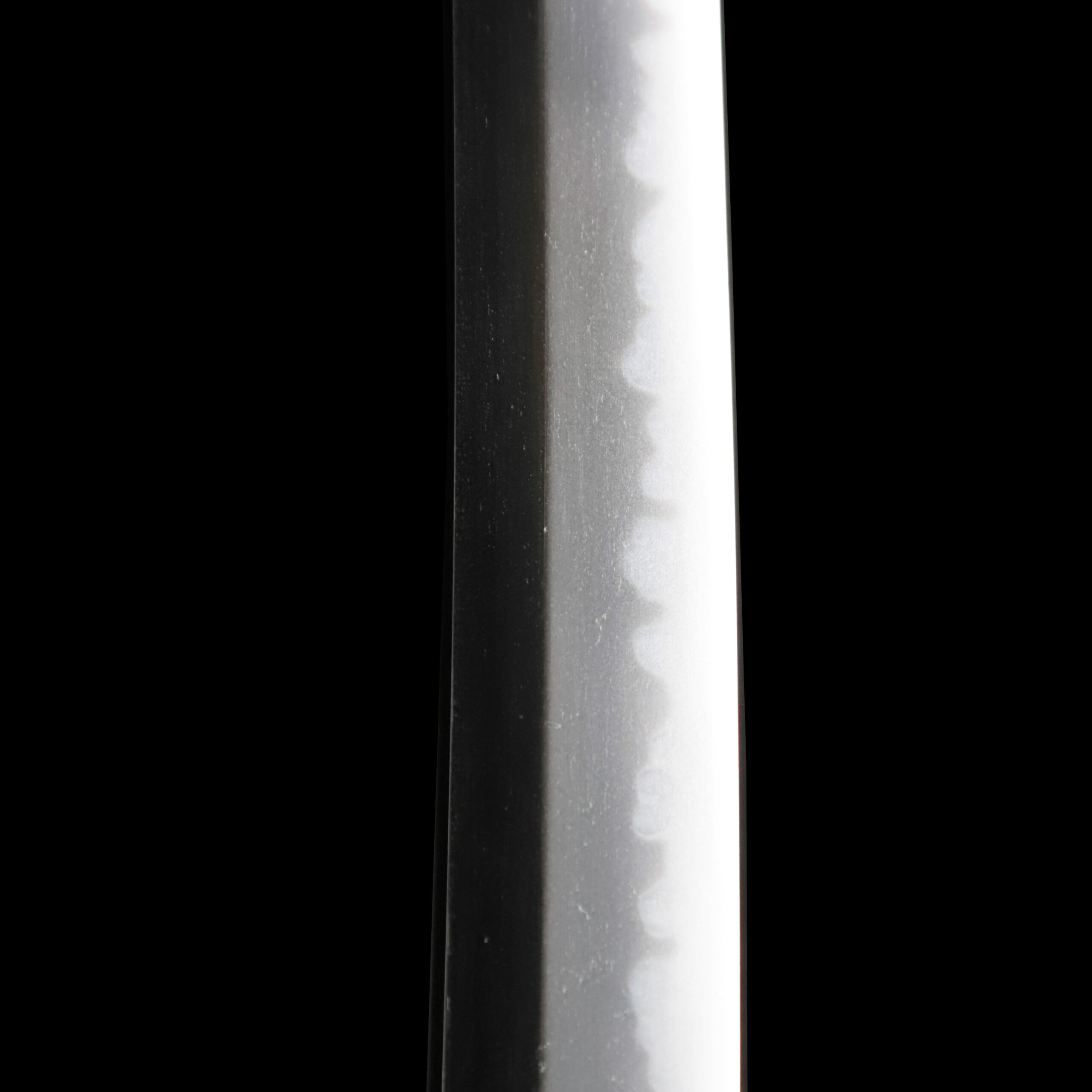
Kissaki: Kissaki is the tip of the Japanese sword.
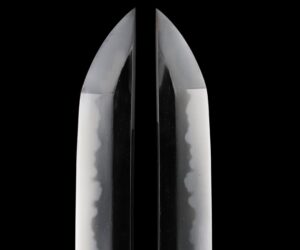
Nakago:Nakago is the tang of the Japanese sword.
Japanese swordsmiths left the black rust on the tang because it prevents red rust while the tang is in its handle. And the discoloration of the tang was created over time, and it is a great indicator for a Japanese sword specialist to estimate when the sword was forged.

Koshirae: Koshirae is the mounting of the Japanese sword. There are several parts that consist of Koshirae such as Saya(Scabbard), Tsuka(Handle), Tsuba(Handguard).

Fuchi-Kashira:A pair of matching sword fittings that cover the upper and bottom parts of its sword hilt.
A classical motif called the Nami Chidori (波千鳥) is designed on this Fuchi Kashira. The Nami (波) means waves, and Chidori (千鳥) is a plover. The waves are rough yet elegantly depicted, and adorable little birds are seen flying in the sky. Golden paint is applied to these birds. The Nami Chidori pattern represents a happy marriage and family safety. In Japan, people have treated it as a good omen design since the Nara period (648-781). Waves are compared to the world, which describes determination: overcoming difficulties with a partner even if there are small or big waves (difficulties/ troubles). Also, the plover pattern is used as a prayer. The Japanese name of the plover, Chidori, was associated with the word Chidori (千取り, which literally means get a thousand). Therefore, its design contains prayers for victory and wishes for goal achievement.

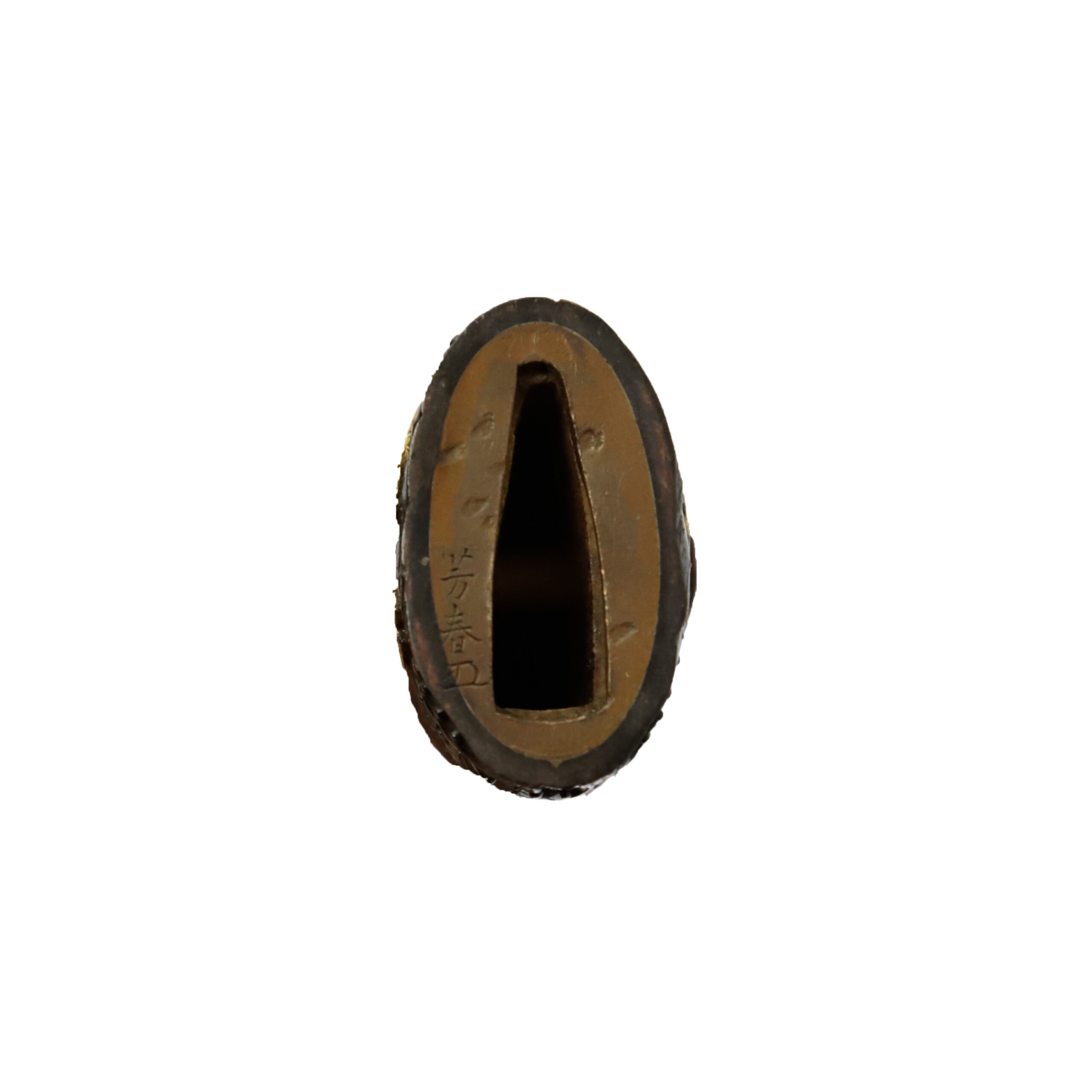
Tsuka and Menuki:Tsuka is the handle of the Japanese sword and Menuki is its decoration.
Leaves are the motifs of this Menuki. It is challenging to judge what kind of these leaves are by seeing them from the gaps of the Tsukamaki thread. Since we could see the traces of golden color, we estimate that this Menuki was initially decorated with golden paint. This sword mounting has a graceful impression due to its design.


Tsuba and Habaki:Tsuba is the handguard for the Japanese Sword and Habaki is the equipment to make the blade not touch its scabbard inside. It prevents the blade from getting rusty and chipped.
This iron Tsuba has an irregular shape. The motif that forms the outline of this work is the Aoi (葵) leaves. In addition, the Karakusa (唐草, arabesque) pattern is inlaid with brass. This brass inlay remains in relatively good condition and adds decorativeness to this work. Since Aoi leaves have a habit of always facing the sun, and the word “Aoi” is taken as “Aogu (仰ぐ, looking up)” for the sun, people thought the Aoi pattern would bring good fortune. Also, the Karakusa design has auspicious meanings. It is a pattern in which vine stems and leaves are twined and make curves. Since ivy has a strong vitality and grows without interruption, people regarded this design as a symbol of prosperity and longevity. In this way, these auspicious motifs were incorporated into the design of this Tsuba.
If you focus on the center part of this Tsuba, you will find the Mei (銘, engraved inscription). It is engraved as follows: 越前住 記内作 (Echizen-Ju, Kinai Saku). It means Kinai, who lived in Echizen, made this Tsuba. Echizen is today’s Fukui prefecture. Please note that no proof appraises this signature. Kinai Tsuba was established in Echizen, and Kinai school flourished very much. Their creations were called Kinai Bori (記内彫) or Echizen Bori (越前彫) and were highly valued. The first Kinai was especially good at dragon motif depiction. The Myochin (明珍) school and the Akao (赤尾) school were also well-known in Echizen. Kinai family was connected to these families by marriage, and three of them prospered together until the last days of the Tokugawa Shogunate.
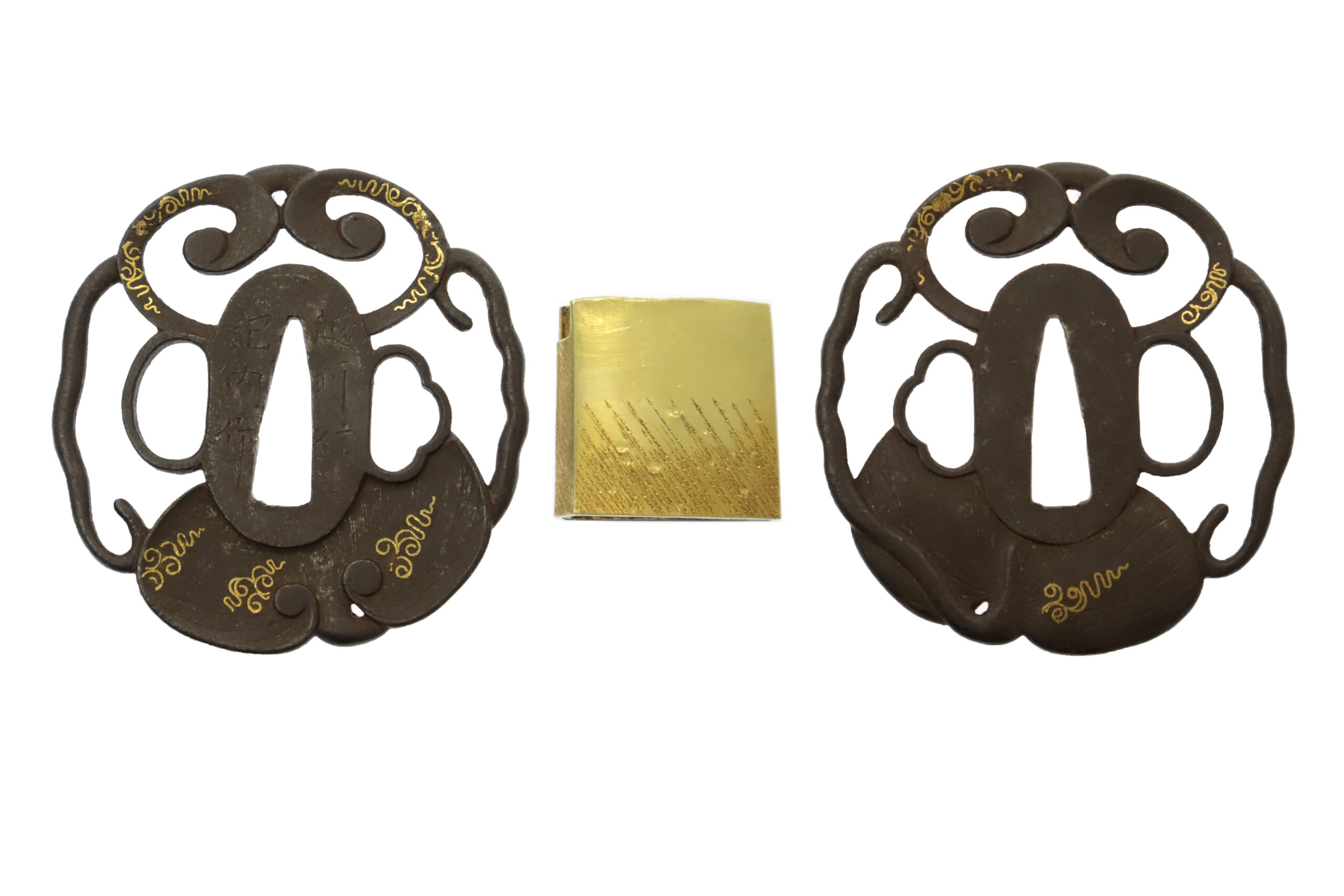
Saya: Saya is the scabbard for the Japanese sword.
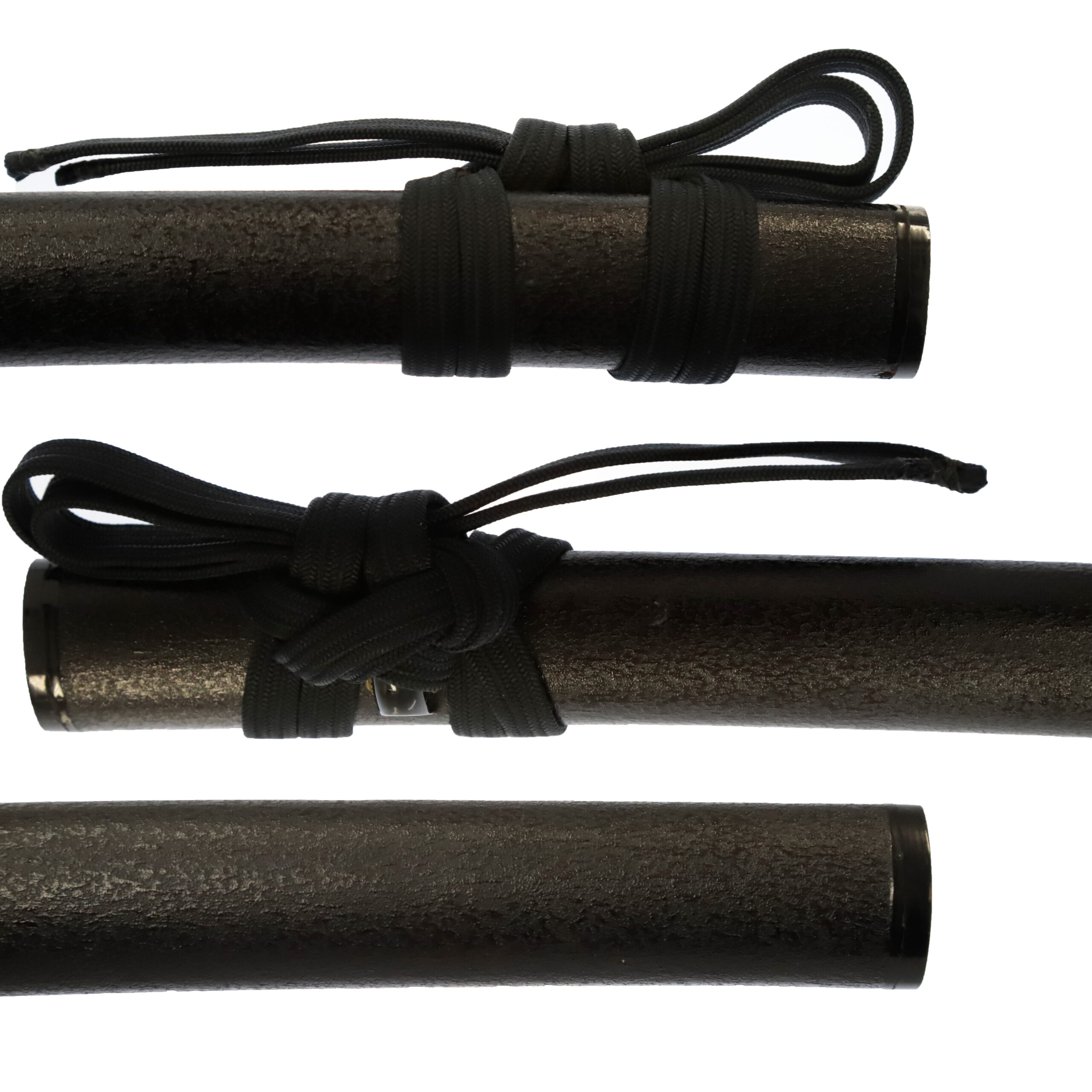
Authentication Paper:NBTHK TOKUBETSU Hozon Certificate for the blade (No. 1021085)
NBTHK, also known as Nihon Bijutsu Touken Hozon Kyokai (the Society for the Preservation of the Japan Art Sword), is one of the oldest Japanese sword appraising organizations in modern-day Japan. They authenticated the blade on Aug 25in the 5th year of Reiwa (2023). They appraised it as Tokubetsu Hozon Touken, the blade especially worth preserving for Japanese society. The purchaser will receive this original certificate as well. We can also translate what is written into English and make a PDF file for your record if you request.
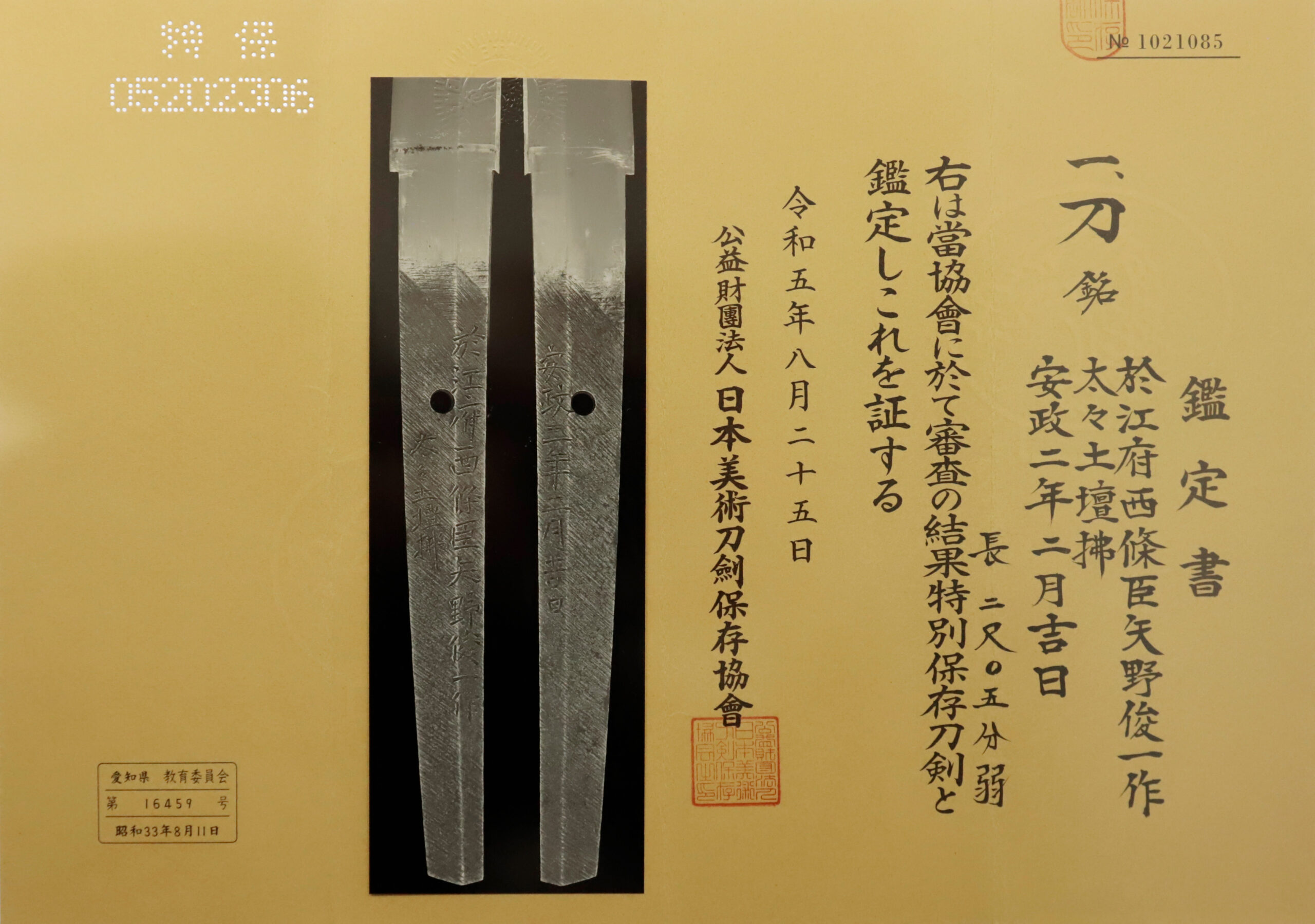
Registration Number : Ehime 16459
The Board of Education in Ehime prefecture issued a registration paper for this sword . It is called Jyu Token Rui Torokusho(銃刀剣類登録証). Bunkacho(The Agency for Cultural Affairs) acknowledges a Japanese sword with this paper as a work of art.
The sword needs to be traditionally hand-forged and made of Tamahagane carbon steel to be registered in the system. With this paper, its owner in Japan can legally own an authentic Japanese sword. Based on this registration number, we will apply for its export permit.
This paper will need to be returned to the board of education when the sword is being shipped abroad, but you can receive a copy of it. An English translation of this registration paper is available on request.
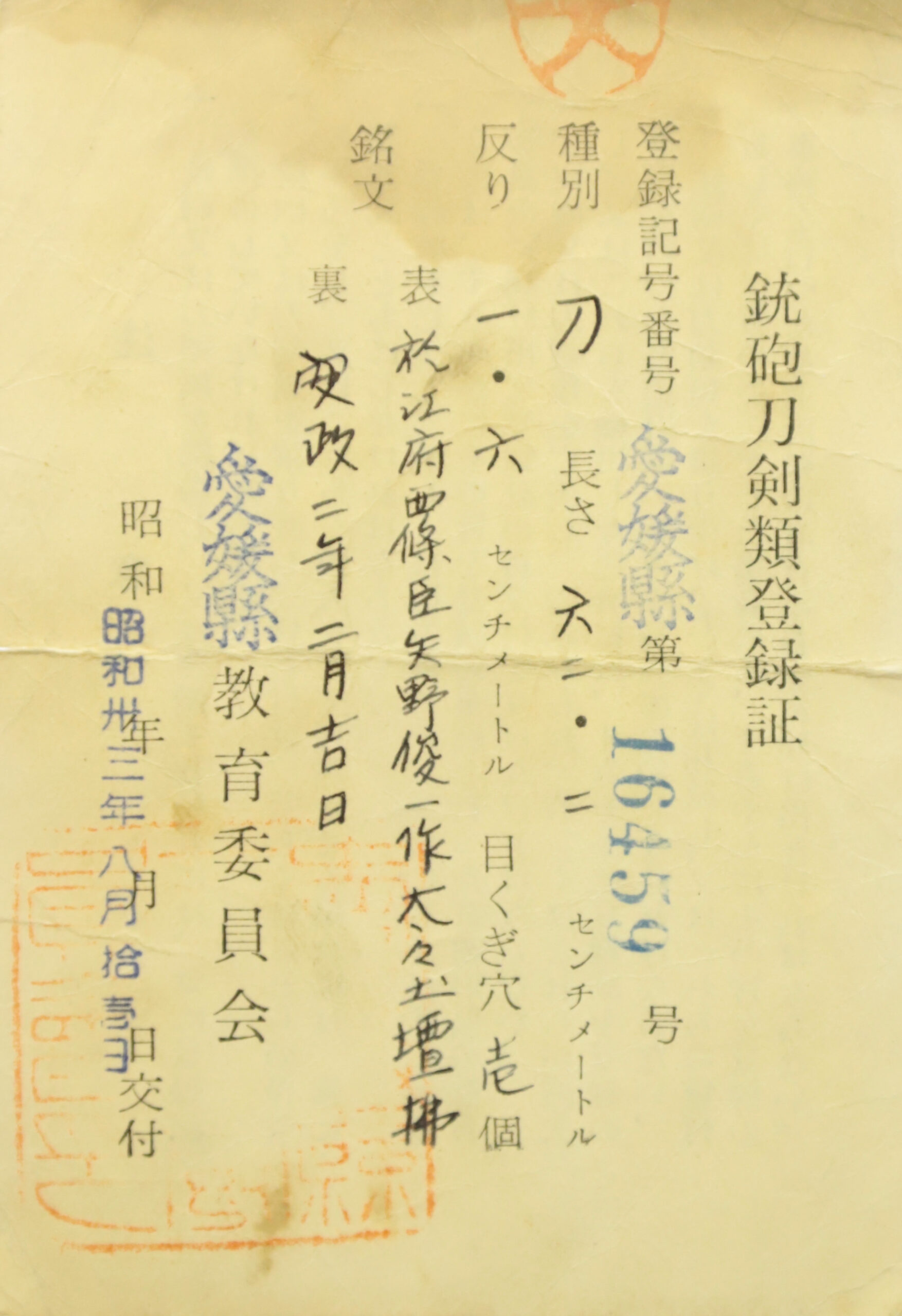
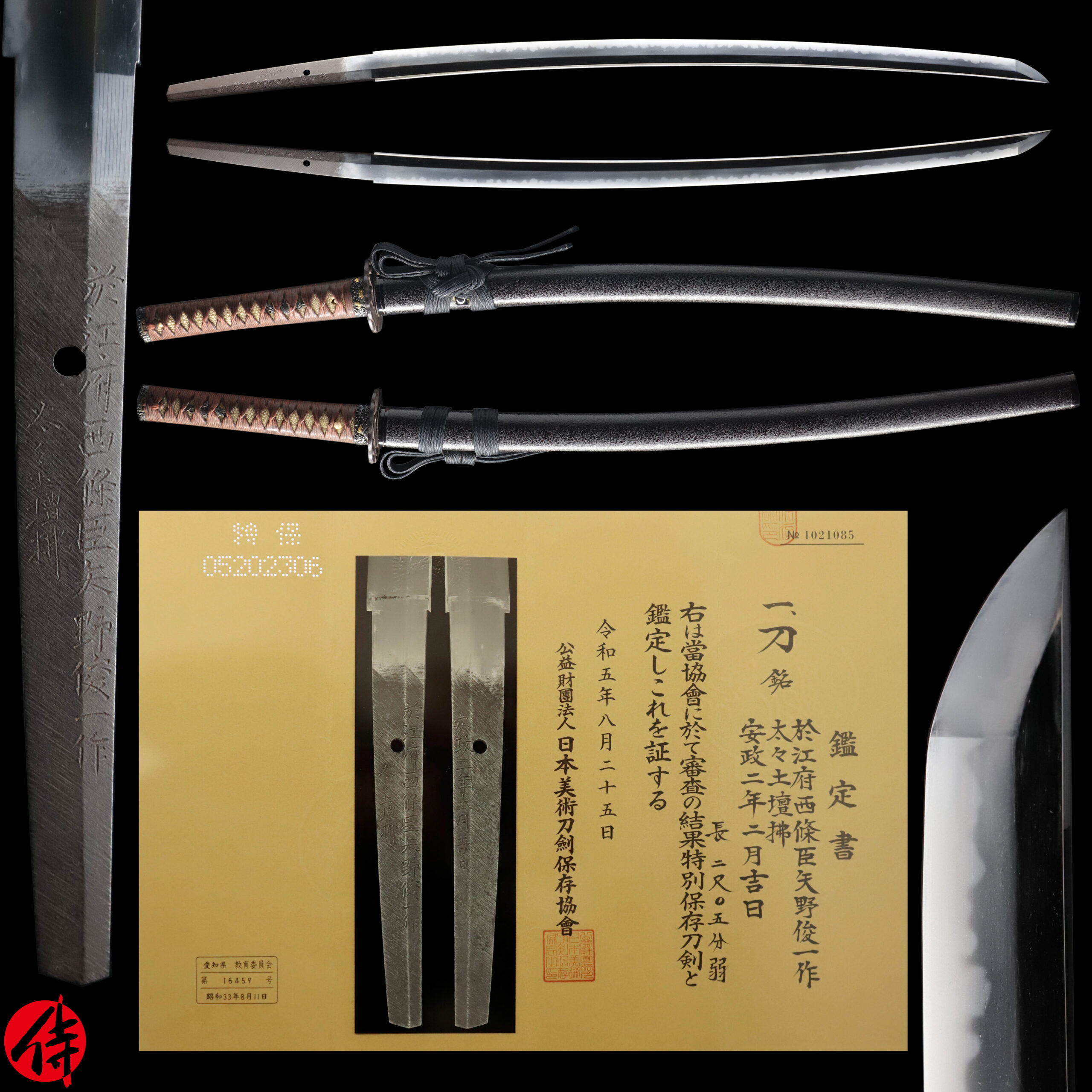
—————————————————————–
【About us】
Samurai Museum is located in Tokyo, Japan, exhibiting antique artifacts related to the Samurai history. Samurai Museum Shop is the place for those who are interested in Japanese culture and craftsmanship. We deal with antique Samurai swords/armor, traditional crafts made in Japan and so on.
【Japanese Sword& Export Process】
The Japanese swords we deal with are hand-forged edged swords made in Japan. It was made from the traditional carbon steel called TAMAHAGANE(玉鋼). Samurai Museum is familiar with the proper legal procedure for an antique/ authentic Japanese sword to be exported from Japan. We have sent more than 700 Japanese swords for the past few years (~2024) to amazing owners who appreciate its historical value.
Each Japanese sword is registered under the Agency for Cultural Affairs and the Board of Education in Japan. They issue a registration paper for each Japanese sword for its owner in Japan to legally possess it. The Japanese sword with its registration paper means it was traditionally hand-forged in Japan.
To legally export the sword from Japan to other countries, we will have to apply for its permit to the Agency for Cultural Affairs(Bunkacho) and return the original registration paper to the Board of Education. It normally takes around 2-4 weeks to receive this permit after submitting required documents. And we would like you to expect at least 1-1.5 months for your order to arrive at your given address after you ordered. For more detailed info, please click here.
It is allowed for residents in Japan to own authentic Japanese swords without a special license as long as they come with registration papers. Please feel free to contact us if you are a resident of Japan, whether temporarily or permanently. We will also assist you when you leave Japan and need to obtain an export permit. If you live in Japan, please click here before you make a purchase.
【Payment Method】
We accept payment through Stripe (Credit card), PayPal, Apple Pay or ChromePay, all of which are secure payment methods. Also, you don’t need to make an account on Stripe for the checkout. If you prefer other payment method, please contact us. After confirming your payment, we will apply for an export permit. You may either pay in JPY, USD, AUD, CAD,EUR CHF or GBP. The price is set in Japanese Yen. Prices in other currencies are automatically calculated based on the latest exchange rate.

* If the amount is above 1 million JPY, Stripe or wire transfer will be the only options for payment.
【Shipping】
We have shipped authentic Japanese swords to the USA, UK, Canada, Mexico, Germany, France, Hong Kong and Australia. If you don’t live in these countries and like to order, please contact us first before making a purchase. We offer Free International Shipping as long as we can send antique Japanese swords by EMS.
We normally ship by EMS(Express Mail Service) provided by Japan Post. We will send you a tracking number for your order as soon as we hand it to the post office. We will put 100 % insurance on the shipping document without any extra charge. Based on the total amount, there might be a duty tax or other fee for you to pay, depending on the countries. We use package cushioning to protect the item and put it in a PVC pipe, which is one of the most secure packages because of its durability.
It will normally takes 5-14 days for the item to arrive at your given address after we dispatch it. Time of delivery is estimated as accurately as possible by the carrier but does not take into account any delays beyond our control such as by inclement weather, post office holiday seasons.
* If you live in Australia and like to purchase an authentic Japanese sword, please click here to know the detail.

【Review】
Here is one of the reviews we received from a customer who purchased an authentic Japanese sword from us. For more reviews, please click here.
“My experience overall with the whole process was wonderful. I had many questions about the history and process to purchase these treasures. All my questions were answered very timely and complete. The staff is very knowledgeable and very well versed if any questions do arise.”
【How to make sure the condition】
Please keep in mind that what you are going to purchase is an antique item. We uploaded high resolution photos for you to check its condition thoroughly. If you like to see more photos with different angles, please feel free to contact us. We will be happy to send them to you so that you can make informed decision. It is essential for us to know that you are happy with your choice of a sword. and we are prepared to use the best of our ability to serve you.
【How To Contact Us】
Please contact us through email, Facebook Messenger or Live Chat if you have any questions. You can find each icon on the right side of the website. Please click one of them to reach us. We will reply to you within 1-2 business days.
【The Art of Nihonto (Japanese Sword)】
Samurai’s history is a profound, eloquent legacy of ancient Japanese warriors in which millions of people worldwide are being fascinated. If you like to find out the art of Nihonto, please click here.
【A Guide to Japanese Sword Maintenance】
After acquiring an genuine Japanese sword, it is also important to know how to take good care of it. Here is the special video for you. Mr. Paul Martin, Japanese sword expert, shows you how to give proper maintenance to your sword. By mastering how to clean the Japanese sword, its aesthetic beauty will last forever.
When you purchase a Japanese sword from us, you can get a Free Japanese sword maintenance kit. It comes with four tools(Choji Oil, Uchiko Whetstone Powder, Peg remover, Oil Applicator). By watching the video instruction above , you can enjoy learning how to maintain your Japanese sword while appreciating it. If you have any difficulty assembling the sword or cleaning the blade, you can feel free to contact us.


MORE ANTIQUE JAPANESE SWORD FOR SALE
SWORDS WITHOUT CERTIFICATES FOR SALE
LEARN JAPANESE SWORD TERMINOLOGY
Thank you for reading all the information on the page. If you have any difficulty choosing the right Japanese sword for you, we will be more than happy to help you find the one that speaks to you the most. Please feel free to contact us.

